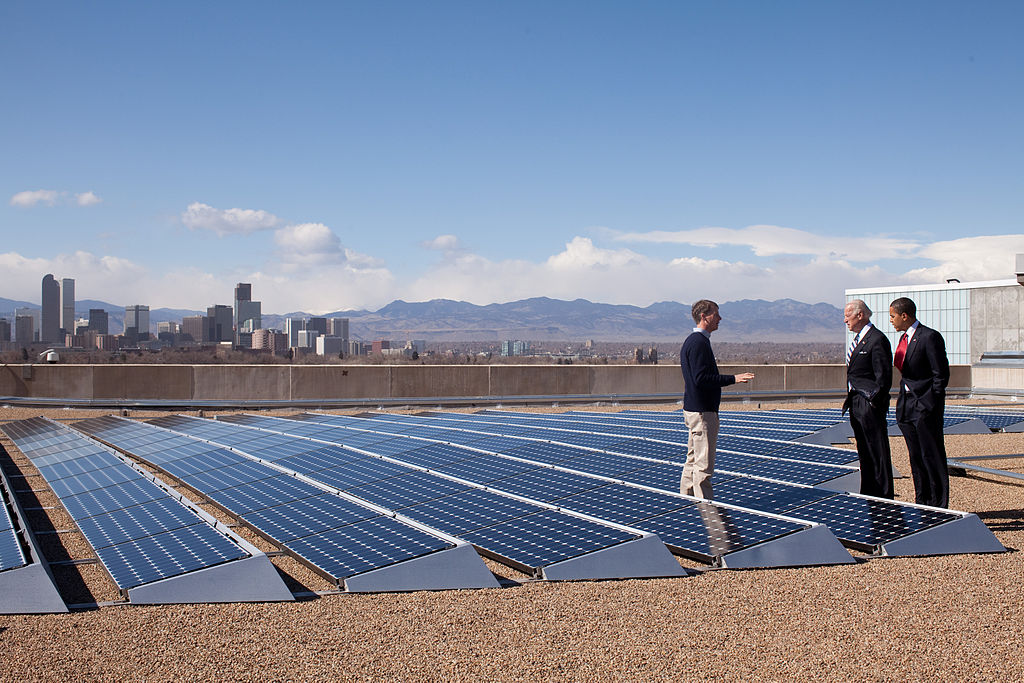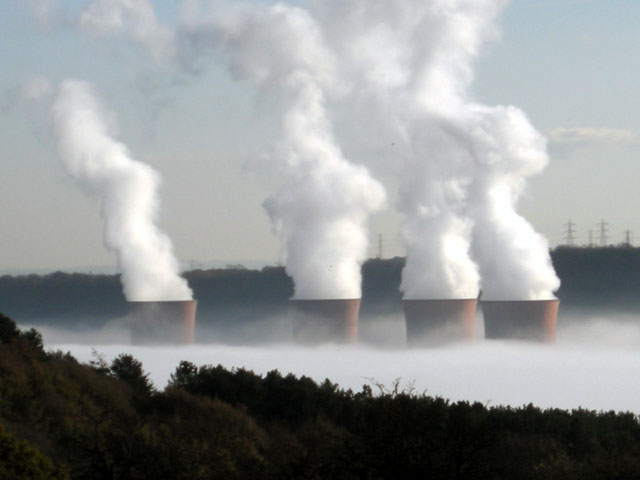The Energy Information Administration (EIA) recently highlighted a little-discussed benefit of using renewables like wind and solar to produce electricity: Unlike most power sources, they require “almost no water.”
This is remarkable because thermoelectric power generation is the leading use of water in America. (That said, only three percent of power generation’s 133 billion gallons a day of water is considered “consumptive use,” as the U.S. Geological Survey says, “meaning it is lost to evaporation or blowdown during generation.”)
According to the latest U.S. Geological Survey (USGS) data from 2015, 41 percent of the water used in America is for power generation. The next highest use is irrigation for agriculture, accounting for 37 percent of U.S. water use (and close to two-thirds of that is consumptive).
The Union of Concerned Scientists was raising this alarm in 2012 when the nonprofit created an infographic focused on the “energy-water collision,” which “refers to the range of issues that can crop up where our water resources and our power sector interact.” That can include increased competition for dwindling water sources and problems when the water going into or out of power plants is too warm.
Credit: Union of Concerned Scientists, 2012
Why does producing electricity require so much water?
As the Department of Energy (DOE) notes: “The main demand for water within a thermoelectric power plant is for condensing steam. Thermoelectric power generation typically converts the energy in a fuel source (fossil, nuclear, or biomass) to steam and then uses the steam to drive a turbine-generator.” This varies somewhat for natural gas, depending on the type of turbine.
With many areas of the world, including large parts of America, already dealing with droughts and water shortages — problems expected to be exacerbated by climate change — the water intensity of power sources becomes another factor for local, state, and regional planners to consider.
United States Drought Monitor November 13, 2018 update. Credit: United States Drought Monitor
Coal’s Decline Brings Slight Progress
The recent topline analysis from the EIA about water use for all energy sources in America is encouraging. Since 2014 the amount of water used to produce energy has been steadily declining.
USGS data show this has been the trend since 2005: “The 2015 estimates put total withdrawals at the lowest level since before 1970, following the same overall trend of decreasing total withdrawals observed from 2005 to 2010.” Over a five year period from 2010 to 2015, water use for power generation dropped 18 percent.
Much of this drop can be attributed to the decline in coal as a fuel source for electricity generation, as well as power plant closures and new plants implementing more water-efficient technologies.
U.S. Electricity Generation 2014-2017. Credit: Energy Information Administration
However, while the decline of the coal industry has meant power plants overall are using less water in the U.S., some of the power sources that are replacing coal, namely natural gas, are still highly dependent on water.
While the natural gas industry’s claim that methane-rich gas is a cleaner “bridge fuel” to the future — an argument thoroughly debunked when accounting for globe-warming methane leaks in the supply chain — water use is another reason to consider wind and solar power over natural gas.
Due to the various technologies used in natural gas power plants, some are more highly dependent on water than others. This variation makes it difficult to quantify just how much water natural gas power generation uses as a sector compared to coal. However, it is safe to say that natural gas power production uses less water than coal in general. Thus, the switch from coal to gas is contributing to the overal decline in water use for power generation, as the USGS and DOE say.
As solar and wind become increasingly cost competitive with natural gas for electric power generation — especially in water-constrained areas of the country — they have the added advantage of being a water smart choice.
Steam rises from the cooling towers of Ironbridge Coal Power Station. Credit: John Horton, CC BY 2.0
Arizona: A Drought-Stricken State Votes Down Renewables
As previously reported on DeSmog, Arizona’s Proposition 127 was a ballot measure that would have required electric power companies to generate half of the state’s energy from renewable sources by 2030. It was voted down by 70 percent of voters after the industry-backed group Arizona for Affordable Energy spent more than $30 million opposing Proposition 127.
But for Arizona, a rising concern may be the idea of affordable water. Phoenix is proposing a hike in water rates for the city for the next two years, citing the “drought and looming shortages on the Colorado River” as reasons for the increases.
According to NASA, earlier this year the U.S. Drought Monitor identified about 97 percent of Arizona as being in severe drought, and 16 percent of that area qualifying as being in exceptional drought.
Arizona relies heavily on the Colorado River for its water — like many of the drought-stricken U.S. states in the West. Arizona’s Water Future, a report by Western Resource Advocates, notes that in the decreasing levels in the Colorado River may result in striking day-to-day impacts “that could have a devastating impact on Arizona’s communities, environment, and economy,” including stopping some suburban development and central Arizona agriculture.
And that is just the beginning of what is likely due to the “structural deficit” in the Colorado River between supply and demand. According to the 2017 report, the river simply cannot support all of its current users, even in normal, non-drought conditions.
“We are prepared for shortages, but we are not prepared for a worst-case scenario,” said Kathryn Sorensen, director of water services for the City of Phoenix, told Water Deeply. “There are some real challenges ahead of us.”
Simply switching power generation to wind and solar will not solve the monumental water scarcity issues facing Arizona and many other areas around the world, but continuing to use water-hungry power sources when viable alternatives are available certainly does nothing to even begin addressing those issues.
Water: The Oil of the 21st Century
Ten years ago, the CEO of Dow Chemical, Andrew Liveris, called water “the oil of the 21st century,” a phrase since repeated in numerous news stories in the decade that has followed.
With global oil demand in 2018 reaching 100 million barrels a day for the first time, oil is not yet a commodity of the past century. Not only is that oil consumption worsening climate change, which is worsening water scarcity for much of the world, the oil industry itself is at times directly competing for that scarce water in certain areas.
In 2014 Mother Jones reported the following:
“The West’s fracking boom was putting new strains on the system; according to one study, energy companies controlled more than a quarter of the flow in the upper Colorado basin. In drought-plagued Texas, ranchers and cities already were being priced out of the water market by oil and gas interests.”
As with power generation, oil production — especially when it involves fracking — uses large amounts of water, often in very dry areas of the country.
As one investor buying up water resources explained to Mother Jones at the time: “It’s the most necessary of all commodities. There’s no substitute for it at any price.”
Main image: President Barack Obama wth Vice President Joe Biden speaks with CEO of Namaste Solar Electric, Inc., Blake Jones, while looking at solar panels at the Denver Museum of Nature and Science in 2009. Credit: White House, public domain
Subscribe to our newsletter
Stay up to date with DeSmog news and alerts










